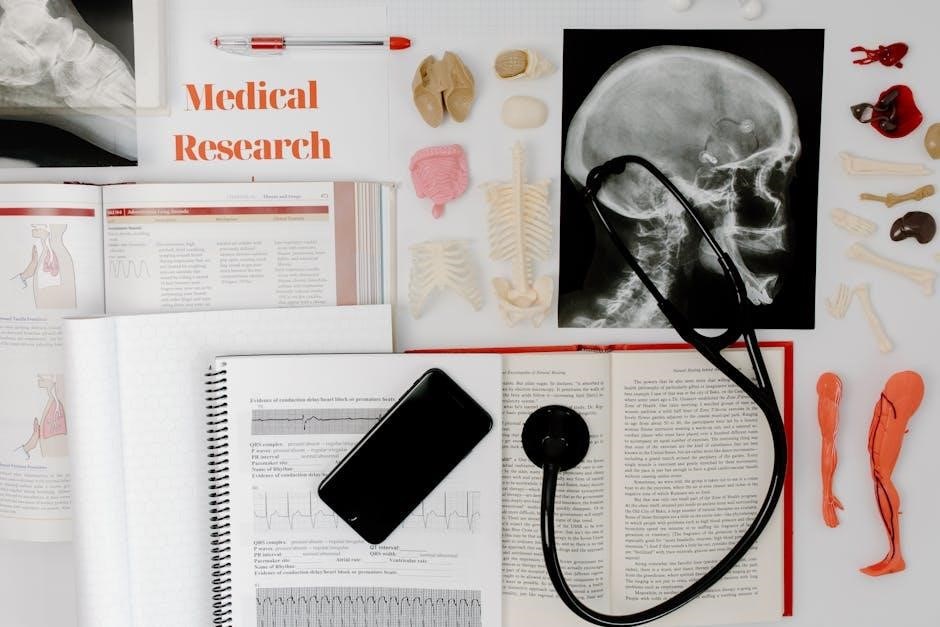The TEAS exam is a standardized test for nursing school admissions, assessing academic skills in Reading, Math, Science, and English. It is divided into four sections, with the Math portion focusing on numbers, algebra, measurement, and data interpretation. Practice tests are essential for preparing for this critical exam, helping candidates improve their calculation and problem-solving abilities, which are vital for success in healthcare careers. Using TEAS Math practice test PDFs allows students to familiarize themselves with the exam format and content, ensuring they are well-prepared for test day.

Overview of the TEAS Math Section
The TEAS Math section includes 38 questions to be answered in 57 minutes. It covers numbers, algebra, measurement, and data interpretation, focusing on operations, equations, and data analysis. This section assesses essential problem-solving skills for nursing and healthcare careers.
Key Topics Covered in TEAS Math
The TEAS Math section evaluates essential skills in numbers, operations, algebra, measurement, and data interpretation. Key topics include solving equations, understanding ratios, and interpreting graphs. The section is divided into three main focus areas: Numbers and Algebra (18 questions), Measurement (14 questions), and Data Interpretation (6 questions). Questions cover concepts like fractions, decimals, percentages, and algebraic expressions. Measurement topics involve time, temperature, and conversions. Data Interpretation includes analyzing tables, charts, and graphs to draw conclusions. These topics are fundamental for nursing professionals, as they require accurate calculations and data analysis in healthcare settings. Practice tests highlight these areas, helping candidates master mental math and problem-solving strategies. Familiarizing oneself with these topics through practice test PDFs ensures better preparation for the exam.
Question Types and Time Limits
The TEAS Math section consists of 38 questions, with a time limit of 57 minutes. Questions are primarily multiple-choice, focusing on problem-solving and calculation skills. They cover a range of topics, including algebra, numbers, measurement, and data interpretation. The section is divided into three main categories: Numbers and Algebra (18 questions), Measurement (14 questions), and Data Interpretation (6 questions). The time limit emphasizes the need for quick and accurate problem-solving, as well as effective time management. To succeed, candidates must practice under timed conditions to build speed and confidence. Utilizing TEAS Math practice test PDFs helps familiarize test-takers with the question formats and time constraints, ensuring they are well-prepared for the actual exam. Proper preparation allows students to allocate their time wisely and tackle each question efficiently.

Importance of Using TEAS Math Practice Tests
Using TEAS Math practice tests is crucial for exam success. These resources provide realistic question formats, time constraints, and content alignment with the actual test. Regular practice enhances problem-solving skills, boosts confidence, and identifies weak areas for focused improvement. By simulating exam conditions, practice tests help candidates manage their time effectively and reduce test-day anxiety. Utilizing TEAS Math practice test PDFs ensures a thorough understanding of the material and improves overall performance, making them an essential tool for achieving a high score.
Benefits for Exam Preparation
Using TEAS Math practice test PDFs offers numerous benefits for exam preparation. These resources provide students with realistic exam simulations, helping them familiarize themselves with the test format, question types, and time constraints. By practicing with actual test-like materials, candidates can identify their strengths and weaknesses, allowing for targeted study. Detailed answer explanations in these PDFs enhance understanding and improve problem-solving skills. Additionally, practice tests boost time management abilities, reducing anxiety during the actual exam. Regular use of TEAS Math practice tests ensures a deeper grasp of essential concepts, such as algebra, measurement, and data interpretation. Furthermore, these PDFs are easily accessible and portable, enabling studying anywhere, anytime. Consistent practice with these materials significantly enhances overall performance and confidence, making them an indispensable tool for achieving success on the TEAS Math section.
How Practice Tests Improve Scores
TEAS Math practice test PDFs significantly improve scores by familiarizing candidates with the exam format and content. Regular practice helps identify weak areas, allowing focused study and improvement. Detailed answer explanations in these tests enhance understanding of complex topics, such as algebra and data interpretation. By simulating real exam conditions, practice tests improve time management skills, reducing stress during the actual test. Candidates learn to prioritize questions, allocate time effectively, and avoid common pitfalls. Additionally, these PDFs provide opportunities to refine problem-solving strategies and mental arithmetic, which are critical for success in the Math section. Consistent practice builds confidence and accuracy, leading to higher scores. Over time, these resources help candidates master essential skills, ensuring they are well-prepared to achieve their goals on the TEAS exam and advance their nursing education.

Best TEAS Math Practice Test PDF Resources
Top-rated websites like NurseHub and Smart Edition Nursing offer free TEAS Math practice test PDFs with detailed explanations. Paid resources provide comprehensive study materials, ensuring thorough preparation for the exam.
Recommended Websites for PDF Downloads
Several websites provide high-quality TEAS Math practice test PDFs to aid in exam preparation. NurseHub offers free downloadable tests with detailed answer explanations, while Smart Edition Nursing provides comprehensive study materials, including full-length practice exams. The ATI official website is another reliable source, offering authentic practice tests designed by the exam creators. Additionally, Spalding University Math Lab and TestGuide.com offer free and paid resources, including formula sheets and study guides. These websites are trusted for their accurate content and realistic question formats, which closely mimic the actual TEAS exam. By utilizing these resources, students can access a wealth of practice materials to improve their math skills and overall exam performance. These PDFs are ideal for self-paced study and can be easily downloaded for convenient access. They are essential tools for anyone aiming to excel in the TEAS Math section;
Free vs. Paid Resources: Pros and Cons
When preparing for the TEAS Math section, students can choose between free and paid resources. Free TEAS Math practice test PDFs are readily available online and provide a good starting point for exam preparation. Websites like NurseHub and Smart Edition Nursing offer free downloadable tests with answer explanations, allowing students to assess their skills without financial investment. However, free resources may lack the depth and variety of questions found in paid materials. Paid resources, such as those from ATI and TestGuide.com, offer comprehensive practice tests with detailed explanations, study guides, and formula sheets. While they require a financial commitment, they provide a more immersive and realistic exam experience. Ultimately, free resources are ideal for initial practice, while paid resources are better for in-depth preparation. Balancing both can maximize study efficiency and effectiveness.

Structure of a TEAS Math Practice Test PDF
A TEAS Math practice test PDF typically includes 38 questions, mirroring the actual exam’s structure. It covers numbers, algebra, measurement, and data interpretation, with a 57-minute time limit. Answer keys and explanations are often included for self-assessment and improvement.
Full-Length Practice Tests: Mimicking the Real Exam
Full-length TEAS Math practice tests are designed to replicate the actual exam experience, featuring 38 questions within a 57-minute time frame. These tests cover the same topics as the official exam, including numbers, algebra, measurement, and data interpretation. By taking these practice tests, students can assess their readiness and identify areas needing improvement. The structure closely mirrors the real exam, allowing candidates to familiarize themselves with the question types, time constraints, and content distribution. Many practice tests include answer keys and detailed explanations, enabling self-assessment and targeted study. Regularly using full-length practice tests helps build test-taking stamina, reduces anxiety, and ensures a smooth transition to the actual exam environment. These resources are indispensable for anyone aiming to achieve a high score on the TEAS Math section.
Section-Specific Focus Areas
The TEAS Math section is divided into key focus areas, including Numbers and Operations, Algebra, Measurement, and Data Interpretation. Practice tests often highlight these specific domains, allowing students to concentrate on their weakest areas. For instance, questions on numbers and operations may involve integers, fractions, and decimals, while algebra problems focus on solving equations and graphing. Measurement questions assess understanding of units and conversions, and Data Interpretation tests the ability to analyze charts and graphs. Targeted practice tests enable students to refine their skills in each category, ensuring comprehensive preparation. By addressing each focus area individually, candidates can systematically improve their performance and approach the exam with confidence. These section-specific resources are tailored to address the unique demands of the TEAS Math exam, providing a clear path to mastery.

Effective Study Tips for the TEAS Math Section
Master essential math concepts using flashcards and formula sheets. Focus on weak areas through targeted practice tests and detailed answer explanations. Consistent review ensures improved problem-solving skills and exam readiness.
Creating a Study Schedule
A well-structured study schedule is crucial for effective preparation. Dedicate specific times daily to focus on TEAS Math topics, ensuring consistent progress. Allocate 1-2 hours for practice tests and concept review. Start with foundational topics like numbers and algebra, gradually moving to advanced areas. Use free TEAS Math practice test PDFs to simulate exam conditions, timing yourself to build speed and accuracy. Review answer explanations to identify and address weak areas. Incorporate short breaks to maintain focus and avoid burnout. Track your progress weekly, adjusting the schedule as needed. Prioritize problem-solving techniques and mental arithmetic to enhance performance. Utilize formula sheets and study guides alongside practice tests for comprehensive preparation. A structured plan ensures efficient use of time, helping you feel confident and ready for test day.
Focusing on Weak Areas
Identifying and addressing weaknesses is vital for improving TEAS Math scores. Use practice test PDFs to pinpoint areas where you struggle, such as algebra or data interpretation. Once identified, dedicate extra study time to these topics. Practice problems from these sections regularly, ensuring a solid understanding. Review answer explanations to grasp concepts and avoid repeated mistakes. Focus on building foundational skills, as they are often tested extensively. Utilize formula sheets to reinforce key equations and relationships. Allocate specific days to weak areas, gradually increasing difficulty as confidence grows. Timing yourself during practice helps simulate exam conditions, improving speed and accuracy. By targeting weaknesses systematically, you can turn them into strengths, boosting overall performance and confidence for test day.

Utilizing Flashcards and Formula Sheets
Flashcards and formula sheets are invaluable tools for mastering TEAS Math concepts. Flashcards can help memorize key formulas, terms, and equations, making them ideal for quick review sessions. Formula sheets provide a concise reference for essential mathematical relationships, such as algebraic expressions and geometric formulas. By organizing these resources, you can focus on high-yield topics frequently tested on the TEAS exam. Annotate formula sheets with examples and tips to enhance understanding and retention. Use flashcards to identify areas where you need more practice, ensuring no gaps in your knowledge. These tools are particularly useful for reinforcing mental arithmetic and data interpretation skills, which are critical for success in the TEAS Math section. Regular use of flashcards and formula sheets, combined with practice tests, will strengthen your command of mathematical concepts and improve your exam performance.

Common Mistakes to Avoid in TEAS Math
One of the most common mistakes in the TEAS Math section is rushing through problems, leading to careless errors. Many students also struggle with misinterpreting question requirements, resulting in incorrect answers. Time management is critical, as spending too long on one question can leave insufficient time for others. Neglecting to review basic formulas before the exam is another oversight, as familiarity with essential math concepts is vital. Additionally, misreading data interpretation questions or failing to use the provided calculator when permitted can hinder performance. Students often underestimate the importance of mental math practice, which is key for tackling algebra and measurement problems efficiently. Finally, ignoring weak areas identified through practice tests can lead to recurring mistakes. Addressing these issues through focused study and practice can significantly improve scores and confidence in the TEAS Math section.

How to Register for the TEAS Exam
Registering for the TEAS exam involves several straightforward steps. Start by visiting the official ATI website and creating an account if you don’t already have one. Once logged in, navigate to the TEAS exam registration section and select your preferred test date and location. Ensure you have a valid form of payment for the exam fee. If you’re taking the exam remotely, select the remote proctoring option and review the technical requirements. After completing the registration, you’ll receive a confirmation email with details about your test. On test day, arrive early or log in on time if taking the exam remotely, and bring a valid ID. Results are typically available immediately after completing the exam and can be accessed through your ATI account. Proper registration ensures a smooth testing experience, so double-check all details before finalizing your setup.

Preparing for the Exam Day
Ensure you arrive early, bring a valid ID, and necessary materials like a calculator. Familiarize yourself with the test format and avoid prohibited items. Stay calm and manage your time wisely during the exam.
What to Expect on Test Day
On test day, arrive early to complete check-in and security protocols. Bring a valid ID, a calculator (if permitted), and any other required materials. The exam is proctored, and you’ll have access to a calculator for the Math section. The test is divided into four sections: Reading, Math, Science, and English. Each section has a set time limit, with the Math section allowing 57 minutes to answer 38 questions. Prohibited items include cell phones, wallets, and extra papers. The test environment is quiet and structured to minimize distractions. After completing the exam, submit your test and await your results, which are typically available immediately. Familiarize yourself with the format and timing through practice tests to ensure confidence and readiness.
Recommended Materials to Bring
On test day, it’s essential to bring specific materials to ensure a smooth experience. First, bring a valid government-issued ID for verification. A calculator is permitted for the Math section, so ensure it’s an approved model. Wear comfortable clothing and stay hydrated by bringing a water bottle. Stationery items like pens or pencils are also recommended. Avoid bringing prohibited items such as cell phones, wallets, or extra papers, as they may cause delays or disqualification. Familiarize yourself with the testing center’s policies beforehand. Organize your materials the night before to avoid last-minute stress. Practice tests can help you understand what to expect and ensure you’re prepared with the right tools. By bringing the correct items, you’ll be able to focus on performing your best during the exam.
